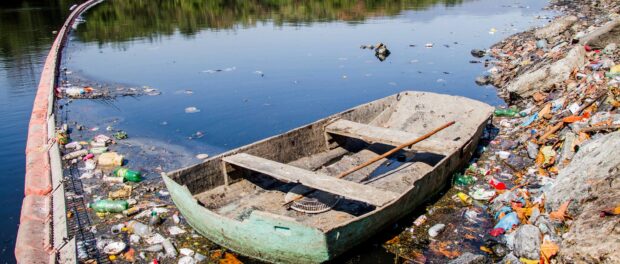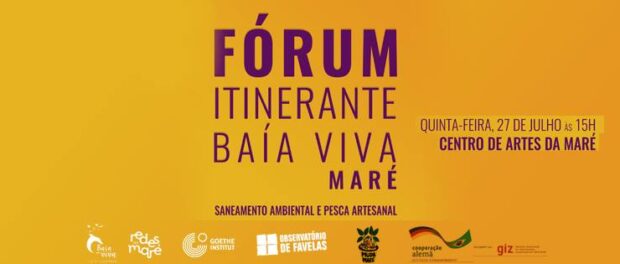
On July 27, community, municipal, and environmental organizations gathered in Maré to discuss 22 years since the Guanabara Bay Remediation Program (PDBG) was initiated, and the unfortunate consequences for the region of two decades of failed public policy in cleaning up the Bay. The Guanabara Bay’s pollution was made famous around the world one year ago when Olympic athletes were subjected to its contamination, fruit of continued remediation failures.
At Thursday’s event, the relationship between pollution, quality of life of residents, and the bay was dissected, drawing audience members to understand the interconnectedness of these issues. The event is part of a series of sessions to be held in different communities bordering the Cunha Canal, a waterway in the North Zone that drains to the bay, and considered the most polluted of all the Bay’s waterways. Despite being contemplated in the 1995 PDBG which was funded by the Inter-American Development Bank (IDB) and the Japan International Cooperation Agency (JICA), the region’s sewage was not properly channeled and as a result residents view their local rivers as fetid valleys. These conditions disproportionately affect favela residents.
The July 27 event was organized by a civil society coalition, including Baía Viva (Living Bay), Observatório de Favelas (Favelas Observatory), Redes de Desenvolvimento da Maré (Maré Development Networks), and the Articulating Group of Cunha Canal Sub-basin Residents. The venue, the Maré Center for the Arts, created an exhibit using fishing netting and newspaper clippings to show the chronology of resistance of Maré’s fishermen and pollution in the bay. As attendees arrived, a screen showed clips of Maré’s fishermen at work, separating pieces of trash from their catch.
The first presentation by a representative of Redes da Maré discussed the historical relationship of Maré with the water, noting that houses in Maré began as palafitas, or houses held above water by stilts. The presentation noted the dramatic change to the landscape of the bay nearby with the establishment of the Federal University of Rio de Janeiro (UFRJ) campus on the artificially created Governor’s Island (Ilha do Governador).
To follow, attendees watched a video produced by Brazil’s national health institute, Fiocruz, that focused on waterways in the North Zone. It highlighted environmental projects in the North Zone such as Alemão’s Verdejar. The video identified regional sources of pollution like a petroleum refinery in Manguinhos and the construction of Avenida Brasil, while also pointing out that technology for cleaning the bay exists, and that cities have successfully cleaned up more polluted bodies of water.
Following this, members of the panel introduced themselves and gave short presentations of their work. The panel, mediated by Sérgio Ricardo of Baía Viva, included representative Carlos Braz of Rio’s water utility CEDAE, Ronaldo Teixera of the waste utility COMLURB, president of the Roquette Pinto Resident’s Association, and a representative of the city’s Environment Secretariat.
Braz showcased recent developments in the city’s sewerage system, and proposed extensions through Maré, Alemão, and Manguinhos. He explained that although these projects have already been planned out in detail, “now we are hitting the problem of lack of resources.” This point was later debated by attendees.
Both the representatives from COMLURB and the Environment Secretariat spoke briefly about their work. The Secretariat’s spokesperson described an environmental education program called Eyes on the Trash that functions in Roquette Pinto and Praia de Ramos, communities bordering the Cunha Canal in Maré. The program includes youth education about the bay, and empowerment of youth to become community water stewards. He explained that youth in the program often began feeling a distance between their community and the Guanabara Bay, associating it more with a “postcard” image than with the polluted waters bordering their neighborhood. He also stressed the importance of youth being the ones to circulate messages of environmental protection around their community.
After these presentations, the audience began responding to the ideas presented. The director of Maré Without Borders, a project of Redes da Maré, explained how efforts to reduce pollution in Maré and provide better services are about improving the community’s quality of life. She said they must be thought of as such, rather than as efforts to “eliminate” a risk or issue. Others questioned the validity of the city representatives’ claims that there were no funds to begin North Zone infrastructure projects. One representative of Redes brought to attention that new mayor Crivella’s Strategic Plan for the city did not mention the bay.
Ricardo pointed out that one of the greatest issues confronting water bodies is silting. One way to reduce this was the proposed Serra da Misericórdia Park, which is said to not be moving forward due to lack of resources. Reforesting these hills would prevent sediment from draining into waterways. He also noted that “there needs to be mobilization for [the proposed Maré sewerage project] to leave paper form [and become reality].” He explained that the state of national politics has made it so that these issues of sanitation must be dealt with at a more local level.
After the panel, there was a screening of the film “Fishermen of Maré,” a short documentary that followed a group of fishermen throughout a fishing trip. Along the way, the film underscored the intrusive presence of oil rigs and military spaces in the bay. In one powerful final scene, the fishermen crossed into military-owned waters and were told to leave. Presumably they remained to finish their catch, and the military responded by shooting at the boat. Fishermen could be heard yelling for them to stop, telling them they could kill someone, but the shots continued.
After the film, fishermen from the area, Carlos and Edson, gave a few final words. Carlos explained how a major oil spill in 2000 had tragic consequences for the fish population in the Bay, with many fishermen not receiving compensation. It is now extremely difficult to make a living only from fishing, even though for many, this tradition goes back generations. Carlos affirmed the validity of the film’s final scene, that it is not surprising for there to be “two, three shots for us to leave the area.” Edson also denounced “criminal (oil) leaking” in the Bay, and affirmed that it was the government who “cut our reserve” of fish. The fishermen invited all attendees to a boat tour, bike ride, and gathering which occurred this last Saturday, August 5 in support of fishermen in the Guanabara Bay.
The organization Baía Viva will publish an agenda detailing how the municipal government should address sanitation in order to decrease pollution in the bay. Ricardo, a representative of the organization, emphasized the importance of collaborating among residents, academia, and government, as well as a strong dislike towards proposals to privatize basic services such as water. This event was meant to gather opinions about potential plans and to facilitate exchange of ideas, so that the plan can bring as many benefits as possible to communities and fishermen themselves.


